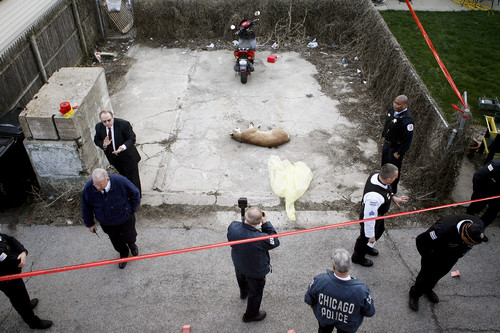
April 15, 2008
“Cougars don’t exist in Illinois,” we have all been told for years, especially before two 21st century incidents began to alert people to the notion eyewitnesses seeing the cats weren’t crazy.
“They are extinct in the state,” officialdom still claimed.
Now, beyond belief, a cougar or puma or mountain lion, whatever you wish to call it, has been killed on the North Side of Chicago on April 14, 2008.
Obtaining an actual body is the ultimate proof, of course.
The Chicago Tribune’s photographer Candice C. Cusic snapped the images on Monday, which sum up the story (below), from the felid body to the human observers:

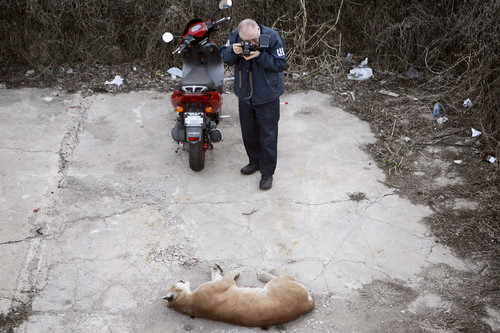
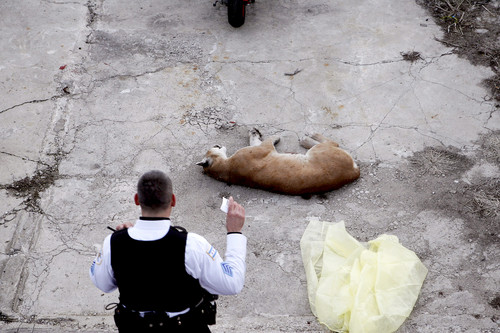
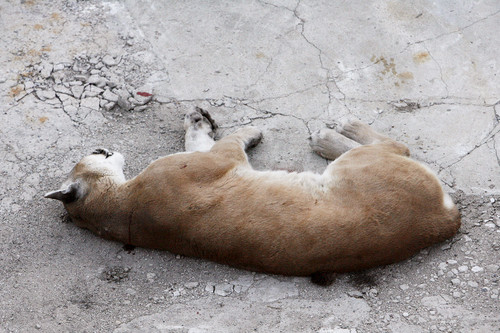
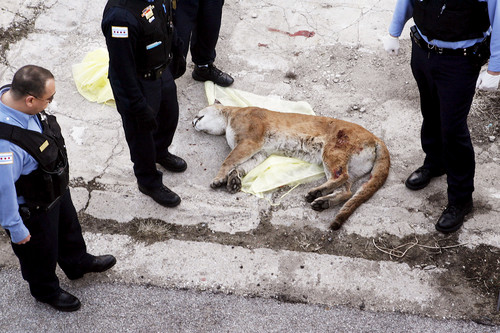


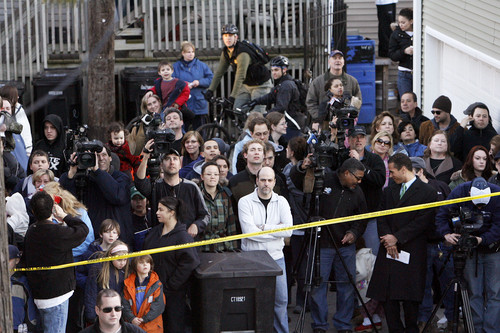
A cougar ran loose in Chicago on Monday for the first time since the city’s founding in the 19th Century. But by day’s end, the animal lay dead in a back alley on the North Side, shot by police who said they feared it was turning to attack.
No one knew where the 150-pound cat came from, though on Saturday Wilmette police had received four reports of a cougar roaming that suburb, roughly 15 miles from the site of Monday’s shooting.
Whatever its origin, the 5-foot-long cougar’s unlikely journey ended in the Roscoe Village neighborhood, where residents reported sightings throughout the day to the Chicago Commission on Animal Care and Control. Resident Ben Greene said police cornered the cougar shortly before 6 p.m. in his side yard on the 3400 block of North Hoyne Avenue.
Greene said he heard a volley of gunfire as he was bathing his 10-month-old son. His wife, Kate, ran upstairs screaming with their 3-year-old son, and they all took cover in a back room.
“At first, I’m thinking there’s a gun battle in the street,” said Greene, who owns a trucking company.
As the shots stopped, Greene heard the police yelling, “We got him! We got him!” He ventured downstairs and moved on his knees to the front door, where he saw police on his lawn. The officers had shot holes in an air conditioning unit on the side of Greene’s house while aiming for the tan cougar, which died in the alley near Greene’s garage.
Chicago Police Capt. Mike Ryan said the cougar tried to attack the officers when they tried to contain it. Police said no one was hurt and they did not know the cougar’s gender.
“It was turning on the officers,” Ryan said, adding that no officers were hurt. “There was no way to take it into custody.”
Normally reclusive creatures, most cougars retreated to habitats in the Rocky Mountains and Black Hills early in American history. But some researchers believe overcrowding in recent years has driven the animals back east.
Two cougars have been killed in Illinois in the last decade. In 2000, a train struck and killed one in Randolph County in southern Illinois, and in 2004 a bow hunter killed a cougar in Mercer County in western Illinois.
But in the previous century, there had been no confirmed sightings in Illinois of a cougar, which is also known as a puma, mountain lion or panther. The last known appearance of the animal was in 1864 at the southern end of the state.
The Wilmette and Chicago sightings capped a flurry of recent cougar activity in the area, though no one knows if that was all the same animal. Several people reported seeing a cougar at the end of March in North Chicago, about 20 miles north of Wilmette. A Wisconsin trapper came face to face with a cougar in January, about 25 miles from the Illinois border.
That trapper said the cat bounded away 12 feet at a leap.
Starting early Monday, frightened Roscoe Village residents began calling police with reports of a cougar which was bounding over high fences in the neighborhood. Greene said his wife got an e-mail alert about the animal Monday morning through a neighborhood watch list.
Frank Hirschmann, 50, of the 3500 block of North Seeley Avenue saw the animal pass by his home.
“I was sitting on the porch, and all of a sudden he crossed the street, and hurdled a 6-foot fence like nothing,” Hirschmann said. He said he then ran into his house and watched police chase the cougar on foot.
Animal control officials were not sure if the cougar was wild or an escaped pet, though they noted that it is illegal to keep the animals as pets. It’s unclear how a cougar could have traveled south into Chicago from Wilmette, but the areas are connected by a Metra train route, on which the cougar could have walked, and a waterway.
Ben Greene’s neighbor, Romeo Dorazio, had just gotten home from dinner when he heard about 10 gunshots.
“I knew it was really nearby. I walked to the window and saw a cougar,” Dorazio said. “It was the freakiest thing I ever saw.”
James Reynolds was sitting in his living room when he heard what seemed like “fireworks popping.”
The 45-year-old went out in his back yard and saw a cougar attempting to jump from his neighbor’s fence to his. He knew it was a cougar because he had seen it on the Discovery Channel, he said.
Officers shouted for him to go inside his house, and he saw them kill the cougar in about 10 shots.
A spokesman for the Illinois Department of Natural Resources said Monday that the state’s current wildlife code does not protect cougars because they are not considered a normal part of the ecosystem here. The official said the only state regulations that might come into play would be gun ordinances, but because police did the shooting that issue is moot.
Greene said he agreed with the police decision to kill the cougar.
“As far as I witnessed, they did a pretty good job,” Greene said. “Hypothetically, if there were kids in the yard and the cougar jumps in, what would the cougar have done?”
Source: “Cops kill cougar on North Side: Neighborhood stunned as animal cornered, shot in back alley”, by Jeremy Manier and Tina Shah, Chicago Tribune, April 15, 2008. Tribune reporter Jeremy Gorner contributed to this report.
About Loren Coleman
Loren Coleman is one of the world’s leading cryptozoologists, some say “the” leading living cryptozoologist. Certainly, he is acknowledged as the current living American researcher and writer who has most popularized cryptozoology in the late 20th and early 21st centuries.
Starting his fieldwork and investigations in 1960, after traveling and trekking extensively in pursuit of cryptozoological mysteries, Coleman began writing to share his experiences in 1969. An honorary member of Ivan T. Sanderson’s Society for the Investigation of the Unexplained in the 1970s, Coleman has been bestowed with similar honorary memberships of the North Idaho College Cryptozoology Club in 1983, and in subsequent years, that of the British Columbia Scientific Cryptozoology Club, CryptoSafari International, and other international organizations. He was also a Life Member and Benefactor of the International Society of Cryptozoology (now-defunct).
Loren Coleman’s daily blog, as a member of the Cryptomundo Team, served as an ongoing avenue of communication for the ever-growing body of cryptozoo news from 2005 through 2013. He returned as an infrequent contributor beginning Halloween week of 2015.
Coleman is the founder in 2003, and current director of the International Cryptozoology Museum in Portland, Maine.
Filed under Alien Big Cats, Breaking News, Cryptotourism, CryptoZoo News, Cryptozoologists, Cryptozoology, Evidence, Forensic Science, Media Appearances, Mystery Cats, Photos